“Lead-Free/ Toxic Metals-Free” Always Pan (From Our Place) tests positive for Lead, Chromium, Titanium, Cobalt & 14 other metals using XRF technology
The product images below are from the manufacturer’s website.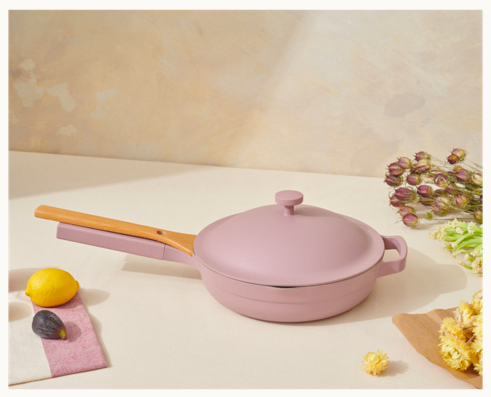
This is an ad-free article.
We are publishing this article as ad-free to make it easier for you to read. If you would like to support our independent consumer goods testing by contributing (which will also help us keep our more widely-read articles ad-free), click here. Thank you!
For those new to the Lead Safe Mama website:
Tamara Rubin is a multiple-federal-award-winning independent advocate for childhood Lead poisoning prevention and consumer goods safety, and a documentary filmmaker. She is also a mother of Lead-poisoned children (two of her sons were acutely Lead-poisoned in 2005).
- Tamara owns and runs Lead Safe Mama, LLC — a community collaborative woman-owned small business for childhood Lead poisoning prevention and consumer goods safety.
- Since 2009, Tamara has been using XRF technology (a scientific testing method) using the exact instrumentation employed by the U.S. Consumer Product Safety Commission to test consumer goods for toxicants (specifically heavy metals — including Lead, Cadmium, Mercury, Antimony, and Arsenic).
- Since July of 2022, the work of Lead Safe Mama, LLC has been responsible for 5 product recalls (FDA and CPSC).
- All test results reported on this website are science-based, accurate, and replicable.
- Items that Lead Safe Mama, LLC reports on are tested multiple times to confirm the results published (for each component tested).
- Tamara’s work was featured in Consumer Reports Magazine in February 2023 (March 2023 print edition) and The Guardian in November 2023.
The screenshot below was taken of the “From Our Place” website listing for the Always Pan:
Below is a screenshot from The Minimalist Baker website, containing some quotes from the Always Pan marketing materials. However, we could not find these exact quotes on the current Our Place (the company that makes the Always Pan) website.
Published: December 7, 2020
While I truly hoped this pan would be Lead-free (as advertised), I was not surprised to learn this claim was simply not true. While the levels of Lead found in the various components and surfaces of the product are very low, the product is not actually Lead-free.
In labeling and marketing their products, many kitchenware manufacturers simply do not understand the distinction between “non–leaching” (i.e. “Our product was subjected to and passed leach testing standards for Lead at the time of manufacture”) and “Lead-free” (or “our product contains no toxic metals”, etc.), which are entirely separate distinctions.
An XRF analyzer is an instrument that can measure total Lead content down to single-digit parts per million as distinct from whether that Lead content is actively leaching at the time of manufacture. When tested with an XRF analyzer (which is what the Consumer Product Safety Commission [CPSC] uses to test for Lead in items intended for use by children), the Always Pan pictured here tested positive for Lead — and other heavy metals — with the following specific readings:
Tested Component #1)
The top surface of the lid
Lavender color-coated metal
3-minute (180-second) test in “Metals & Minerals” mode
- Lead (Pb): 70 +/- 7 ppm (safe according to all standards — but not negative)
- Chromium (Cr): 282 +/- 115 ppm
- Tin (Sn): 25 +/- 6 ppm
- Palladium (Pd): 4 +/- 2 ppm
- Platinium (Pt): 286 +/- 32 ppm
- Zinc (Zn): 2,742 +/- 61 ppm
- Copper (Cu): 3,469 +/- 72 ppm
- Nickel (Ni): 194 +/- 35 ppm
- Iron (Fe): 5,834 +/- 175 ppm
- Manganese (Mn): 589 +/- 129 ppm
- Indium (In): 16 +/- 4 ppm
- Titanium (Ti): 128,600 +/- 2,100 ppm
Additional testing needs to be done to confirm the presence or absence of trace levels of Cadmium and Antimony. Very low trace levels of these two metals were detected using the XRF instrument, but these levels were so low that I would like to do additional testing before definitively stating the pan is positive for these metals.
Tested Component #2)
The gray inner food surface of the pan
3-minute (180-second) test in “Metals & Minerals” mode
- Lead (Pb): 34 +/- 6 ppm (safe according to all standards — but not negative)
- Chromium (Cr): 7,837 +/- 284 ppm
- Tin (Sn): 23 +/- 6 ppm
- Platinium (Pt): 206 +/- 26 ppm
- Zinc (Zn): 1,789 +/- 45 ppm
- Copper (Cu): 4,965 +/- 87 ppm
- Nickel (Ni): 615 +/- 41 ppm
- Iron (Fe): 7,795 +/- 196 ppm
- Manganese (Mn): 480 +/- 148 ppm
- Vanadium (V): 1,039 +/- 230 ppm
- Titanium (Ti): 37,700 +/- 900 ppm
Additional testing needs to be done to confirm the presence or absence of trace levels of Cadmium and Antimony. Same note as above.
Tested Component #3)
The bottom surface of the pan
Lavender color-coated metal
3-minute (180-second) test in “Metals & Minerals” mode
- Tin (Sn): 306 +/- 24 ppm
- Platinium (Pt): 370 +/- 100 ppm
- Zinc (Zn): 2,591 +/- 151 ppm
- Copper (Cu): 355 +/- 77 ppm
- Cobalt (Co): 16,600 +/- 800
- Iron (Fe): 635,200 +/- 17,000 ppm
- Manganese (Mn): 818 +/- 242 ppm
- Titanium (Ti): 243,300 +/- 5,900 ppm
What do these test results mean?
Please note: I do not share the full list of XRF-detectable metals found in each of the products I test to indicate that the presence of any of the specific metals found necessarily represents a potential source of toxicant exposure to the user. I share the full list of metals found so that consumers can make informed choices based on the science and independent testing — not based on marketing materials from the manufacturer or claims made by the vendor.
Several of the metals listed that were found in this pan are considered non-toxic (safe) in most or all applications. I do however have specific concerns whenever I find Lead, Cadmium, Arsenic, Mercury, or Antimony — even in trace amounts — in any product. Of interest, the pan shown here was, in fact, definitely negative for both Arsenic and Mercury.
Given the limitations of XRF testing (which specifically measures the total content of metals for surfaces tested), the testing I complete does not indicate whether the metals detected within the coating(s) and/or substrate(s) of a particular item may be leaching now (nor whether those elements might be leachable in the future).
Newly manufactured cookware sold in the United States is required to be “non-leaching” (for Lead and other toxicants) at the time of manufacture (with specific [non-zero] limits for certain metals). It is possible for a pan that passes leach testing standards at the time of manufacture to start leaching at unsafe levels at some point in its lifespan (especially with regular daily use as intended — and consequent normal wear and tear). You can read more about that concern at this link, here.
Again, as with all of the information reported on this website, I share these test results with you so you can make a more informed choice about what you are buying, digging a little deeper than the information shared by the company in its marketing materials.
Specific Claims of the Always Pan
Claim #1) Toxic Metals-Free?
Some people (in the non-toxic living space especially) assume that if a company claims their cookware is free of “toxic metals,” that means it is free of Aluminum. The substrate of this pan is Aluminum, which is clearly stated in the marketing materials for the product. The pan also tested positive for Chromium and Cobalt, which many people consider to be highly toxic (even though Chromium is a main ingredient present in stainless steel alloys commonly used for cookware). Here’s an article with full XRF test results for a typical sample of stainless steel.
Claim #2) Lead-Free?
Most consumers assume that if a pan is advertised as “Lead-free,” or if the manufacturer states that “Lead is not used” in the manufacturing process, then there will be no Lead in the product.
Generally, when a manufacturer wants to use “Lead-free” as a selling point, they mistakenly assume that if a product is not actively leaching unsafe levels of Lead at the time of manufacture (that the pan passes leach testing within the set regulatory limits, which again are not zero), then they can call it “Lead-free.” Ignoring the possibility of further testing (total content testing done either with an XRF instrument or with destructive laboratory testing), the manufacturer then slaps a “Lead-free” label on the box and includes the false “Lead-Free” claim in their advertising.
Unfortunately, if an item is not leaching Lead (read: “complies with regulatory [non-zero] limits for leaching Lead”) at the time of manufacture, one cannot simply conclude that the item is also Lead-free (as so many manufacturers do)! There are quite a few examples of this here on the Lead Safe Mama website — items marketed as “Lead-free” that I have then tested and found to test positive for Lead (sometimes, even at alarmingly high levels)! Here are a few:
- Organifi glass water bottle
- Ceramcor/ Xtrema/ Mercola “ceramic” pans
- A white ceramic bowl by Dowan
- Boroux glass water bottle
- Paulie Jars (sold by Mighty Nest)
- Sweese brand ceramics
- ForLife brand ceramic mugs
- VitaClay Chef Slow Cooker
- Corkcicle stainless water bottles
- Mexican handmade pottery
I found it interesting that the purple coating on the bottom of the Always Pan was completely negative for Lead, but the gray interior food surface of the pan, as well as the purple coating surface on the lid of the pan both tested positive for trace levels of Lead. The substrate for the top of the pan (both the lid and the top part of the base of the pan) is Aluminum. Cast Aluminum is often contaminated with trace amounts of Lead, so it is very possible the Lead that the XRF instrument is detecting is being picked up through the coating (down below it, from the substrate of the pan) rather than from the surface coating. It’s nearly impossible to determine which component(s) contains the Lead (the substrate or the coating) without destructive testing of the pan.
Here are some other examples of cast aluminum items I have found to test positive for Lead:
Claim #3) “Heavy Metals-Free”
What are “Heavy Metals?”
The quote above (at the top of the piece) from the Minimalist Baker site states that the producer of the Always Pan claims these pans are free of “lead and heavy metals.” We could not find that exact quote on the Our Place site but assume it is legitimate as we have seen it in several places. The definition of “Heavy Metals” is ambiguous at best (https://www.thoughtco.com/definition-of-heavy-metal-605190) and one person could argue that some metals are heavy metals, while another person might disagree. That said, Lead, Cobalt, Chromium, and other metals generally considered to be heavy metals were found in this pan.
Claim #4) Ceramic Coating
“Tamara, I am so confused! I thought these pans were coated with a high-tech ‘ceramic’ coating — not metals!”
Yeah — me too! Gah! So my husband and I have been having quite a discussion over this point. In my opinion (as the daughter of a ceramic artist who raised us in the 1960s and 1970s by selling her pottery at fairs and street markets!), cookware companies today are using some “creativity” in their definition of the term “ceramic.” True ceramics (pottery made from the earth) DO NOT generally test positive for the levels of metals found in these modern “ceramic-coated” pans; there are several examples here on the website with full XRF test results for handmade ceramics to support this assertion. Given the very high levels of metals found in the coatings on so many of these “ceramic” pans (like 128,600 ppm Titanium in the lid of the Always Pan), I think we, as consumers, should just consider claims of products having a “ceramic” coating simply as the latest “buzz word” reeling us in.
Some examples of other ceramic items on LeadSafeMama.com:
- Here’s an unglazed ceramic pot I tested – total METALS detected make up less than 8% of the pot (less than 80,000 ppm total in metals found, leaving 920,000 ppm of the product as a non-metal ceramic substrate)!
- Here is a recently manufactured handmade ceramic mug from Vermont (again, the total metals profile is relatively insignificant).
- Here’s a piece of glazed vintage handmade ceramic pottery — also with a fairly insignificant metal profile.
What’s next, Tamara?
What are you going to do with this pan?
I was really hoping the pan would be Lead-free, and that (after testing it) I could then do a giveaway for it as a prize to one of my readers. Since it did not end up being Lead-free, I cannot — in good conscience/on general principle — use it as a giveaway prize. HOWEVER, my husband is the kind of guy who knows how to work with metal (and he has all the tools in his workshop for various kinds of metalwork). As a result, we have decided in the interest of science to do some additional (destructive!) testing on this pan.
We plan to grind off the coating (using proper PPE and active dust control) to create a “bald spot” on the pan (revealing the metal substrate without the coating) so that the substrate can be tested separately. Since the readings of the bottom of the pan appear to be primarily Iron, and the readings of the lid and interior cooking surface appear to be primarily Aluminum, we will do this for one spot on each of these distinct areas of the substrate. We will then use XRF technology to test the exposed substrate to see what the Lead levels are in the substrate. This will help to determine if the Lead found with this preliminary round of testing is in the coating, the substrate (which is the case with many cast aluminum cookware products), or possibly a combination of both!
Is it more concerning if Lead is in the substrate?
Or is it more concerning if Lead is in the coating?
Of course, it is quite concerning if Lead is in the coating because (if that is the case) as the coating wears, the “worn bits” can come off into your food. It just takes a literally microscopic amount of Lead to poison a human being!
However, I want to be clear that it is also quite concerning if the Lead is in the substrate on a piece of cookware like this. The cookware comes with its own wooden spatula, and I am certain that by including a wooden spatula, the intention is to reduce the likelihood that the coating becomes scratched! Invariably, given that — despite all hype to the contrary — all coatings are subject to wear, someone is likely to eventually use utensils with the pan that will scratch the coating. We have ALL seen what a scratched non-stick-coated pan looks like, right?
So once the coating is inevitably scratched, the exposed substrate under the scratches then becomes part of the pan that touches the food while cooking (cooking is normally done with high heat and often acids like vinegar, tomato, lemon juice, etc.). So if it turns out the Lead is “only in the substrate” there is potential exposure to the user once the substrate is exposed (which I would expect to normally happen after years or even months of daily use as intended).
“What pots and pans do you use, Tamara?”
In our home, we use a combination of clear glass, high-quality stainless steel, and undecorated/unadorned (plain) cast iron. I also like wooden utensils (again, unadorned/undecorated/free of any paint or other coatings). By using a combination of materials for cooking (and not using just one single type of pot or pan) we limit any potential toxicant exposure from cookware for our family.
“What do I mean by potential toxicant exposure from cookware?”
For example, some people have concerns about high levels of the elements Nickel or Chromium, often found in stainless steel cookware. Others have concerns about unsafe levels of Iron exposure when using plain, uncoated cast iron. Since we mix things up in our home (using the least-toxic cookware options available, and never any single pot all the time), I don’t particularly have those concerns.
We also don’t use crockpots or do much “long-form cooking” or “specialty appliance cooking” so we don’t have potential exposure from vessels/devices that one might use for those cooking styles. We keep a mostly vegan household and we don’t feel the need for crock-pots or other plug-in devices (air fryers, waffle irons, panini makers, etc.) for specialty cooking — which is fortunate — because many of those devices rather consistently test positive for metallic toxicants including Lead.
One example: I have never tested a plug-in waffle iron that was negative for Lead! Plug-in waffle irons are normally made of a black coated cast aluminum — so again, it is possible the Lead is in the substrate and not the coating, but for my family, we prefer not to take the risk (and instead we have an antique cast iron stove top waffle iron)!
When one is cooking vegetables primarily, you also cook quickly. So even though we have and use cast Iron several times a week, that has not impacted our iron levels at all (in fact my 15-year-old son who was acutely Lead poisoned as a baby is actually iron-deficient, so I personally have no concern at all for our use of cast iron).
“But I heard stainless steel is not safe…”
I have reviewed several of the published papers summarizing experiments on stainless steel that demonstrate the potential for metals (primarily Nickel and possibly Chromium) to leach from stainless steel pots and pans into the food being cooked in those vessels. From what I have read on this subject, these experiments tend to set up circumstances that are not representative of the normal usage of these pans. These studies seem to (across the board) use EXTENDED (not normal/typical) cooking times, AND the most acidic foods possible (tomatoes/tomato sauce) to see how much of various metals can possibly be extracted from the pans. So, with this context, I don’t have concerns about the NORMAL use of stainless pans.
Exceptions for medical conditions:
Of course, if you have a diagnosed Nickel allergy, I do recommend finding low-Nickel (or Nickel-free) sources of stainless steel (Ikea has inexpensive choices that fit the bill and there are some other examples here on the site as well). Otherwise, I do not personally have a concern when stainless steel products are used as intended. Also, of course, if you have hemochromatosis (and therefore a specific diagnosed medical reason to be concerned about the use of cast iron cookware), all cast iron should be avoided. I am not a doctor, but that’s what the medical experts say!
Cookware the Rubin Family avoids in our home:
I have been doing this work (independent testing of consumer goods) since 2009, and I have developed these guidelines (below) based on tens of thousands of items I have personally tested. One thing a long-time reader or fan of my website will probably be able to tell you is that I prefer to tell my readers what not to buy (vs. offering them suggestions of what to buy)! So this is a list of things you might want to consider NOT buying:
- Enameled cast iron (with enamel either on the inside or the outside of the pan — or on both surfaces). These products can test positive for Lead, Cadmium, and Antimony in the enamels — including on the food surface. They are often also positive for very high levels of Cobalt if they are in the blue-to-purple range.
- Cast iron with decorative elements — or “accents” in other metals or materials (such as brass adornments).
- Anything with silicone that goes in the oven or on the stovetop. Silicone often tests positive for trace levels of Cadmium (at levels most regulatory agencies consider “safe”). Since Cadmium causes cancer, I don’t want it in my kitchen, even at ostensibly “safe” levels.
- Any glazed ceramic cookware that I have not personally tested and found to be free of common metallic toxicants (Cadmium, Arsenic, Mercury, Antimony, and Lead).
- Anything glass that has painted decorative exterior markings (or painted branding) of any color (including glass frying pan lids with white painted logo markings for the brand). The paint on these tends more often than not to be Lead paint!
- Any ceramic long-form cooking vessel (for extended-time cooking, like crock pots with ceramic inserts).
- Anything with a nonstick coating! Again, almost all plug-in appliances I have tested that have any type of non-stick coating have been positive for at least some amount of Lead in the food preparation surface; the Lead levels in these products are often in the 1,000 to 2,000 ppm range. As with this Always Pan, and as stated above about the waffle irons, in many cases, these are cast Aluminum cooking surfaces with a non-stick coating, so it is not always clear from XRF testing alone if the Lead is in the surface coating or if the Lead is in the cast Aluminum substrate.
- Anything Aluminum where the Aluminum component might touch the food (including Aluminum-substrate non-stick cookware where the aluminum will eventually be exposed when the coating wears, which is most non-stick cookware — this would include the Always Pan!
Some additional reading that might be of interest:
- The “Pots & Pans” category of articles on this site.
- To read more about the concern for toxic metals in cookware (over time), click here.
- An article discussing, in detail, the testing methodology for the tests reported on this website.
- My bio 🙂 — the “About” page on this site (also linked in the footer on every page).
- My XRF certification.
For readers who absolutely insist on some product recommendations, please check out my Amazon store.
As always, thank you for reading and for sharing this work. Please let me know if you have any questions. I will do my best to answer them as soon as possible (although — with kids underfoot because of the pandemic, and no childcare since March 2020, it may take a while for me to get back to you)!
Tamara Rubin
Owner – Lead Safe Mama, LLC
A Woman-Owned Small Business For Consumer Goods Safety and Childhood Lead-Poisoning Prevention
#LeadSafeMama
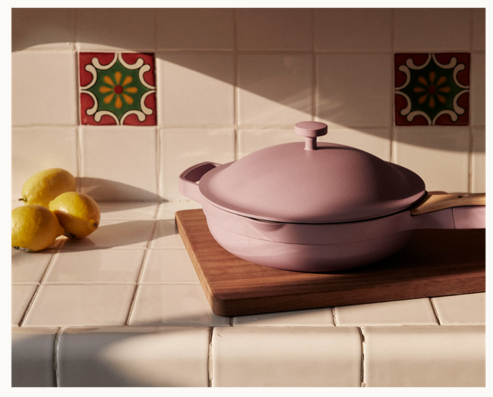
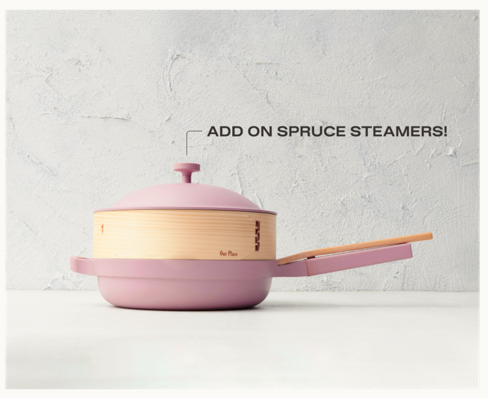
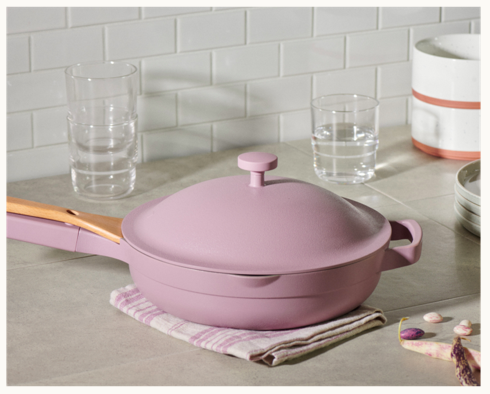

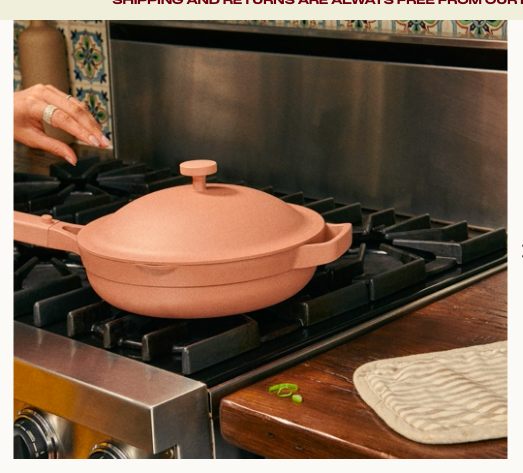
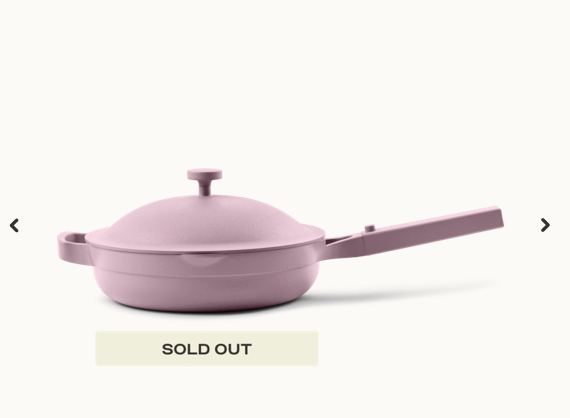
Never Miss an Important Article Again!
Join our Email List








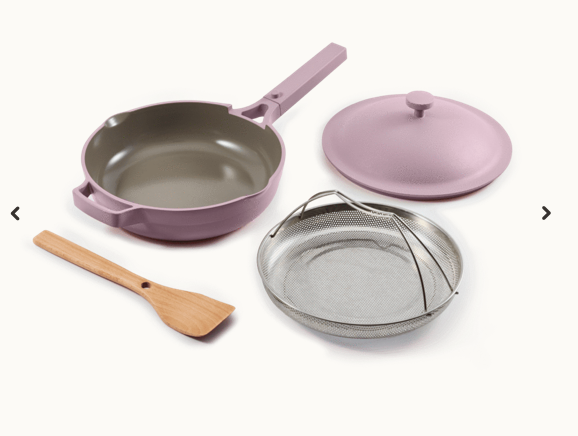
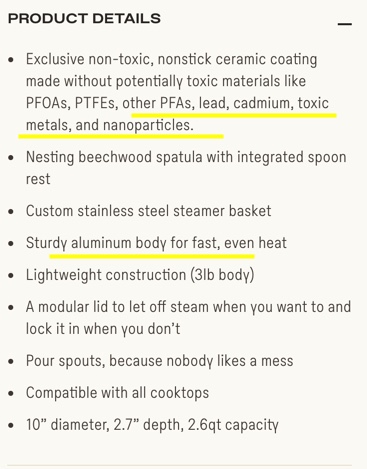
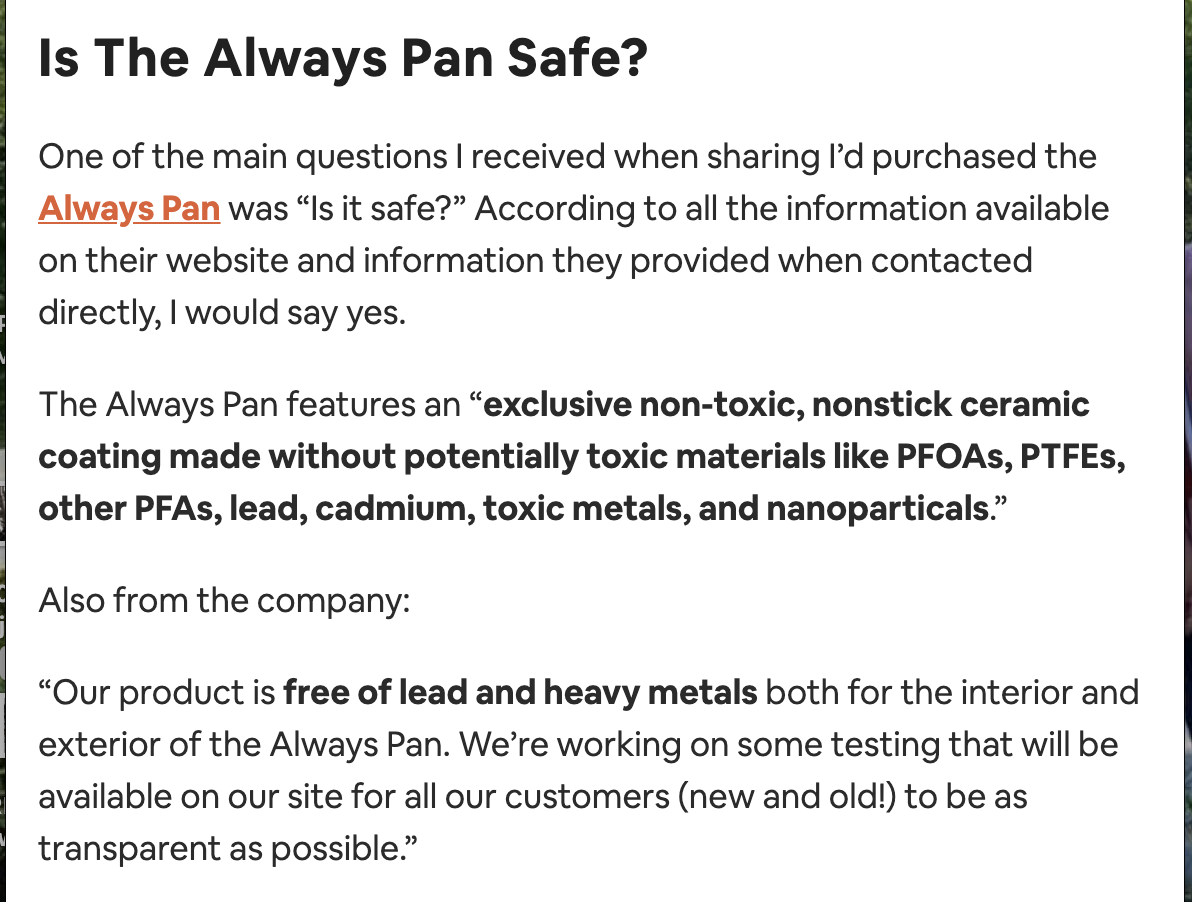
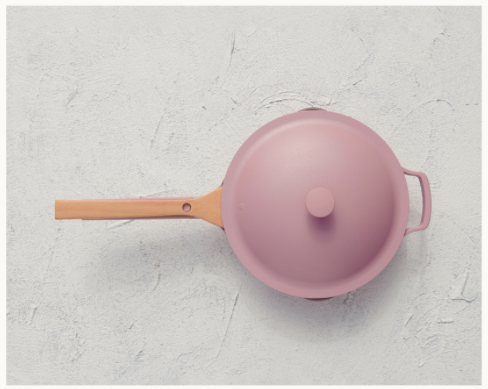

Thank you so much for testing this Tamara as I had my eye on this and was going to buy this pan after the holidays. It seems no pans are safe anymore but iron pans and being I have an electric flat stove burner they aren’t recommended because they are too heavy. What do you suggest now?
Is Stainless and option for you at all?
Yes it is Tamara. Can you recommend a brand for me at all?
Oh good – I wrote this post as a follow up. It has quite a few specific recommendations:
https://tamararubin.com/2021/01/i-want-to-buy-some-nontoxic-cookware-which-pots-pans-are-the-safest-for-cooking-which-pots-pans-are-the-least-toxic/
Tamara
What do you think of All-Clad D3 Stainless Everyday 3-ply Bonded cookware? I know you had 5-Ply Bonded in your amazon store.
I don’t see any tests for Caraway cookware or Made In or Made On stainless steel. Both companies say they are nontoxic so i would love to see if they actually are.
Hi Colette – the way things work here on LeadSafeMama.com is that readers help direct and pay for the testing that is reported on the blog. Here’s a post with more information about that:https://tamararubin.com/2019/08/tamara-can-i-send-you-one-of-my-dishes-to-test-for-lead/
In the case of the Always Pan, a bunch of readers chipped in to cover the cost of purchasing and testing the pan. Here’s the post that discusses how that went down: https://tamararubin.com/2020/12/standby-tunein-alwayspan-leadsafemama-later-tonight-i-will-be-reporting-the-full-xrf-test-results-for-the-our-place-always-pan-in-lavender/
Tamara
Hey Tamera, what are your thoughts on stainless steel pans with aluminum cores? I find it so difficult to find steel cookware that doesn’t have an aluminum core. When this is heated is there any way the aluminum may come through the stainless steel? I have major health issues with aluminum so I don’t want anymore going in my body. Thank you for all that you do. It’s so hard to find safe frying pans for cooking. Was so excited to see you tested the always pan have been wondering about it. Thank you.
I discuss Aluminum a bit on this post. With an Aluminum core pan there is no food contact and the aluminum is not generally exposed at all so I don’t personally have ANY concerns with Aluminum core stainless pans. It is sandwiched between THICK layers of stainless – not just a stainless coating.
Tamara
Thank you Tamara!
What about Homi stainless steel pans that are also Nickel free?
I was eyeing this pan. Disappointed as always. I just stick to my stainless steel and cast iron… I wish you had the money to start your our kitchen and dishware line also is it true that ovens and stove tops have lead? What do we do about that?
Some ovens and stove tops have Lead… it depends on the age, material and manufacturer… I do want to start my own line eventually – but in the meantime just working on getting info out there to help all the families! 🙂
Tamara
Tamera it would be amazing if you start your own cookware line! As someone who is sensitive to almost all metals finding a pan has felt nearly impossible. A ceramic metal free lead safe mama pan sounds like a little piece of heaven! Until then thank you so much for helping us find the safest options out there.
hi Hannah – thank you… it’s on the “to do” list!
Thank you for being here.
I don’t know how new you are here – but if you have only recently found me – check out this video on how house the website to see more of the pots and pans I have tested:
https://tamararubin.com/2020/12/how-to-use-the-lead-safe-mama-website-video/
Tamara
Thank you Tamera. If you release a naturally non stick ceramic frying pan and Dutch oven with no metals in the coating you will have a customer right here!! I wish more companies would do this since it is possible.
Thank you that video was so helpful! Really appreciate how much time you put into all of this to empower family’s to make wise safe choices. Have a blessed holiday season!
Hey there! Thanks for this amazing breakdown. What’s your breakdown on Xtrema cookware?
Thank you!!
Hi Jillian:
Please read this post and ALL the comments (maybe with a bottle of wine? or at least a large glass): https://tamararubin.com/2017/06/mercola_pan/
Please read this too: https://tamararubin.com/2018/08/july-2018-ceramcor-xtrema-saucepan-update/
And here’s the post that has a video about how to use my website (for new folks here!): https://tamararubin.com/2020/12/how-to-use-the-lead-safe-mama-website-video/
Tamara
Thank you for writing this article. I bought a pan thinking it was safe but now I’m going to send mine back. I contacted the company with my concerns and sent them a link to your article and they sent me a report back from a company called Bureau Veritas and it stated in the report that there was NO detections of heavy metals whatsoever. They tested for 5 different heavy metals and there was ND (none detected) which I don’t believe for a minute, Can I email it to you for review? So interesting. I’m sending mine back for a refund.
Hi Laura!
Here’s my response to that: https://tamararubin.com/2020/12/from-readers-our-place-says-their-always-pan-is-lead-free-they-sent-me-their-test-results-tamaracan-you-explain/
Tamara
Thank you so much for following up on this post. I read your new analysis of the pan and situation and I still don’t feel comfortable keeping the pan. My gut says it’s not safe after reading your findings. Thanks again!
Hi Tamara!
Do you have any suggestions/examples/links to nickel free cookware? I saw you mentioned IKEA but I don’t have very one close to me. I was just recently diagnosed with nickel allergy (which makes quite a few things make sense). I’m so glad I found your website and will continue reading more of your posts now too. 🙂
Thanks!
Hi Tamara!
Hoping you are starting to mend. It’s so frustrating! a few questions:
– You recommend the Cuisinart aluminum pots and pans but they have Aluminum encased in the bottom. Is that ok?
-Have you ever tested ALL CLAD stainless pots and pans?
-I have heard that Scan Pan brand has the safest coating if you want to have one or 2 nonstick pans. My kids don’t want to scrub the aluminum so I was wondering if the scan pan coating is truly safe.
– I know that you do not favor Crate and Barel. I have contacted them and they say they are very concerned and cautious about lead in their dishes and glassware and that they are very careful and almost if not everything now tests safe, including CA Prop. Thoughts? Trying to find new white dishes that are modern and safe and nicer than Corelle (already have those). Thank you SOOOO much! Speedy recovery!
Hi Tamara,
I have watched your “how to use the website” video and it was very helpful. I thought I read a blog stating you were not accepting things to be tested at this time due to a backlog (I imagine you do get a lot of items sent to you) but I also thought I saw a more recent comment that said you were still accepting single dishes for testing but it could take up to 10 weeks to get results. Are you accepting single dishes? I just purchased HomiChef pans and am interested in your testing of a single pan. I have searched your website and have not found any testing done on this brand but have found a few people asking about it.
Hi Brittany – yes – here is the post about sending in a single item:
https://tamararubin.com/2019/08/tamara-can-i-send-you-one-of-my-dishes-to-test-for-lead/
Tamara
Thank you for your response! I went ahead and sent you the email (I hope that I followed the instructions correctly.) What is your opinion or knowledge of Chromium in our cookware? I went to your Amazon store and one of the sets of pans is 18/10. I have tried looking for the information on Chromium but get a lot of mixed information regarding its toxicity. Any insight is greatly appreciated!
Hi! I have caraway pans. I would LOVE to drop of a pot and lid for you to test. They claim to be the best non toxic pans. It’s hard to know what to believe! We are also in Portland OR.
Hi Kelly-
Here are the test results for Caraway pans: https://tamararubin.com/2021/08/caraway-cookware-without-the-chemicals-tested-positive-for-20-metals-including-lead-mercury-cobalt-antimony-when-tested-with-xrf-technology/
Hi Tamara,
Thank you for the wonderful work you do. I’m thinking if changing my cookware and was interested in these two: Misen carbon steel cookware and Hestan Nanobond. Both claim to be non toxic and lead free. Have you had a chance to test either of them? Thank you.
Hi Amy – to my knowledge I have not tested either of those.
Here’s how to participate in the testing reported here: https://tamararubin.com/2019/08/tamara-can-i-send-you-one-of-my-dishes-to-test-for-lead/
Tamara
Tamara,
Have you ever looked into Brazilian soapstone cookware? From what im reading they are naturally non-toxic and contain no heavy metals. I am wondering if this is actually accurate and true? Any insight would be appreciated.
Have you ever tested Serfina Cookware from Italy?
Hi Tamara,
I’m curious about titanium specifically… as you detected amounts in this pan. Is titanium unsafe for the human body, any more than nickel or the chromium we’d get from cooking food in a stainless steel pan?
Kind regards,
-Sean
Did you ever get an answer to this? I’m also trying to understand if/how titanium is a health concern.
Oh no. I bought one of these in the spice color. I have some lodge cast iron skillets. I think I will go back to using them. I feel so stupid
Hi- I was curious if you’ve ever tested any of the 360 cookware or bakeware? I was looking for a stainless steel cookie sheet in trying to follow your recommendations to use stainless steel. I looked at all clad but they were backordered. They also have a stainless steel slow cooker that I thought might be of interest to you since I saw another post where it seemed like there weren’t a lot of good options in that space.
Thanks!
Hey! Tamara has recommendations for cookie sheets as well as other baking items in her shop! https://shopleadsafemama.com/
I’ve wondered about the 360 cookware and bakeware too! And if their stainless steel slow cooker is a lead free/heavy metal free option. I would love to hear Tamara’s thoughts on this as well!
Tamara,
I would love to know what are your recommendations for getting a lead training for a new home owner who has bought an older home that has lead paint.
Thank you so much,
Adriana
You need to get an EPA RRP certificate. Look on the EPA’s website for trainers in your region. Depending on where you are I may be able to connect you with a good trainer. Let me know if you cannot find a course. Many are offered online now since the pandemic, but I think a hands-on course makes a lot more sense (given the subject matter!)
Tamara
Also here are a few links you may want to check out:
1. https://tamararubin.com/home-testing/
2. https://tamararubin.com/2020/11/ten-minutes-with-tamara-guest-carissa-b-from-oregon-october-27-2020/
3. https://tamararubin.com/2019/12/start-here/
4. https://tamararubin.com/2017/09/home-depot-the-story-of-when-i-replaced-my-windows-in-2007/
5. https://tamararubin.com/2014/06/now_what/
Tamara
Tamara
Tamara,
Were you and your husband ever able to do that more destructive test on the Always pan? Would love to know any new findings you might have.
Thank you!
Can you please give your opinion of cookware made by All -Clad, Lodge, 360 cookware, Caraway , Greenlife , Made-In and Greenpan
I have read most of the articles in your website, and I had to say I am still kind of overwhelmed and confused, and I just wanted to confirm that the stainless steel cookware that you recommend made by Faber ware, and Cuisinart are in fact some thing that you would use in your own kitchen.? The reason I ask is because especially the Faber Ware is not super expensive for an entire set but yet brands that you may consider risky are much more expensive which I guess shows that cost doesn’t necessarily reflect the quality but I just need for you to confirm, the recommendations that you make on your website before I purchase them
Thank you so much and also unfortunately many of the recommendations that you make , specifically in the pots and pans category, are no longer available and I was wondering if maybe you could find and post replacements for those things that are no longer available to purchase
Again, thank you so much for you do diligence,
Best regards, Denise Toledo Silbert
PS I am not a huge fan of stainless steel because it takes some skill to cook with it and clean and of course, I am disappointed to hear that you do not care for ceramic coated cookware, but I still wanted to find out if maybe the brand GreenPan is an exception in your opinion.
I purchased a few pans a couple years ago. I’ve only used them a few times,but I’m troubled to now realize that they’re ceramic coated “non stick”. They are sold with this in the description; Ceramic Coating is FDA, California Proposition 65 and European Union Approved. The Ceramic Coating is Cadmium, Lead, PFOA, PTFE and PFOS Free. The brand is “Casaware”.
After reading your article I would have to assume these pans aren’t safe? I feel pretty stupid believing they were. Have you heard of this brand? Thanks for your help and all you do!
All of the ceramic coated pans test similarly. They are cast aluminum with a titanium dioxide coating.
T
Tamara: my takeaway from this and similar items that you’ve tested is that cutesy products—better than everyone else’s because we do XYZ special new process or use QRS fancy materials—are almost never safe for household use, especially long-term. The most basic, simple things remain the most safe: plain cast iron, stainless steel, glass, etc. Nobody’s going to coo over them when you’re hosting, but there are 1,000 better ways to make your house a home. Plants are beautiful and restful. Warm lighting is important and helps people feel instantly at home. The smells of good cooking make people smile involuntarily. Your gracious welcome is the most important thing, not your matching “porcelain” cookware!
Exactly!
I also got some marmoleum flooring that I just love (in my kitchen in the boys’ playroom) and it brings me so much joy – simple, non-toxic (I heard it’s even edible and reusable!) – There are many beautiful things that are not toxic.
T
What about the Always Pan Pro? It has an entirely different coating that they say is only titanium, the nonstick claim comes from the pattern on the titanium’s surface.
https://fromourplace.com/products/titanium-always-pan-pro?variant=44381106045122
A review of that one would be nice
Did you ever do the testing on the destruction? Curious about the inside of this pan
Have you tested Scan Pans?
I know you say the pans on GreenPan are not good. Do you also feel their waffle maker and other appliances are bad too? Do you recommend products that are safe?